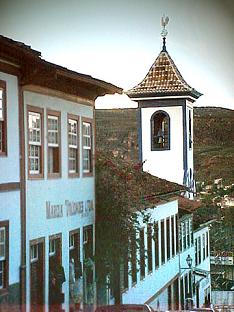Advertising by Google
Diamantina
Population: 44,259
Distance from Belo Horizonte: 285 km (177 mi)
In the 17th century, Diamantina was reached by the bandeirantes, the explorers who braved the Brazilian interior in search of gold and precious stones and ended up conquering a good part of Brazilian territory.
The name Diamantina comes from "diamante", the Portuguese word for diamond. While neighbour cities like Ouro Preto and São João del Rei were gold producers during colonial times, Diamantina was the most important diamond producer in Brazil.
Diamantina is today a World Heritage Site and is the best preserved of all historical cities of Minas, although it is not as rich as Ouro Preto. Some streets of the historic center still have the original rough stone pavements, which makes the transit of cars difficult; the best way to explore the area is on foot.
Diamantina - places to see
 Religious buildings. The most opulent church in Diamantina is the Igreja Nossa Senhora do Carmo, which houses a 600 pipe organ adorned with gold. It is said that the main tower of the church was placed at the back of the buildings because the slave Chica da Silva, who became mistress of a high representative of the Portuguese Crown, disliked the chime of bells.
Religious buildings. The most opulent church in Diamantina is the Igreja Nossa Senhora do Carmo, which houses a 600 pipe organ adorned with gold. It is said that the main tower of the church was placed at the back of the buildings because the slave Chica da Silva, who became mistress of a high representative of the Portuguese Crown, disliked the chime of bells.
The neo gothic Basilica do Sagrado Coração de Jesus was built at the end of the 19th century, and sports French stain glass windows. The Metropolitan Cathedral, despite its ancient look, was built in the 1930s.
Casa de Chica da Silva. It is said that this black slave was so beautiful that not only did she become mistress of João Fernandes de Oliveira, lieutenant of the King, but also had strong influence over him. Chica da Silva became theme of songs and movies in Brazil.
Passadiço da Glória. This walkway links two buildings from the 18th and 19th centuries. The first was the home of Diamantina's first bishop, João Antônio dos Santos; the other building belonged to the Nossa Senhora das Dores Catholic School. Rumours say that the walkway was built by the nuns, to ensure the privacy of their pupils.
Slave's Route. The route between the villages of Tijuco and Medanha was travelled in the 18th century by slaves carrying out bags of diamonds; part of the route was restored and made accessible to tourists.
Museum of Diamond. Exhibits ancient equipments, furniture and religious art pieces. No diamonds, though.
House of Juscelino Kubitschek. The house where ex-President Juscelino Kubitschek spent his infancy is now open for visitation.
Tijuco Hotel. The hotel was one of the early works by Oscar Niemeyer, who would become a world famous architect after designing the most important buildings in Brasília.
Hotels in Diamantina
Hotels in Diamantina. List of hotels in Diamantina.
More sites about Diamantina:
Diamantina.
Back to Top